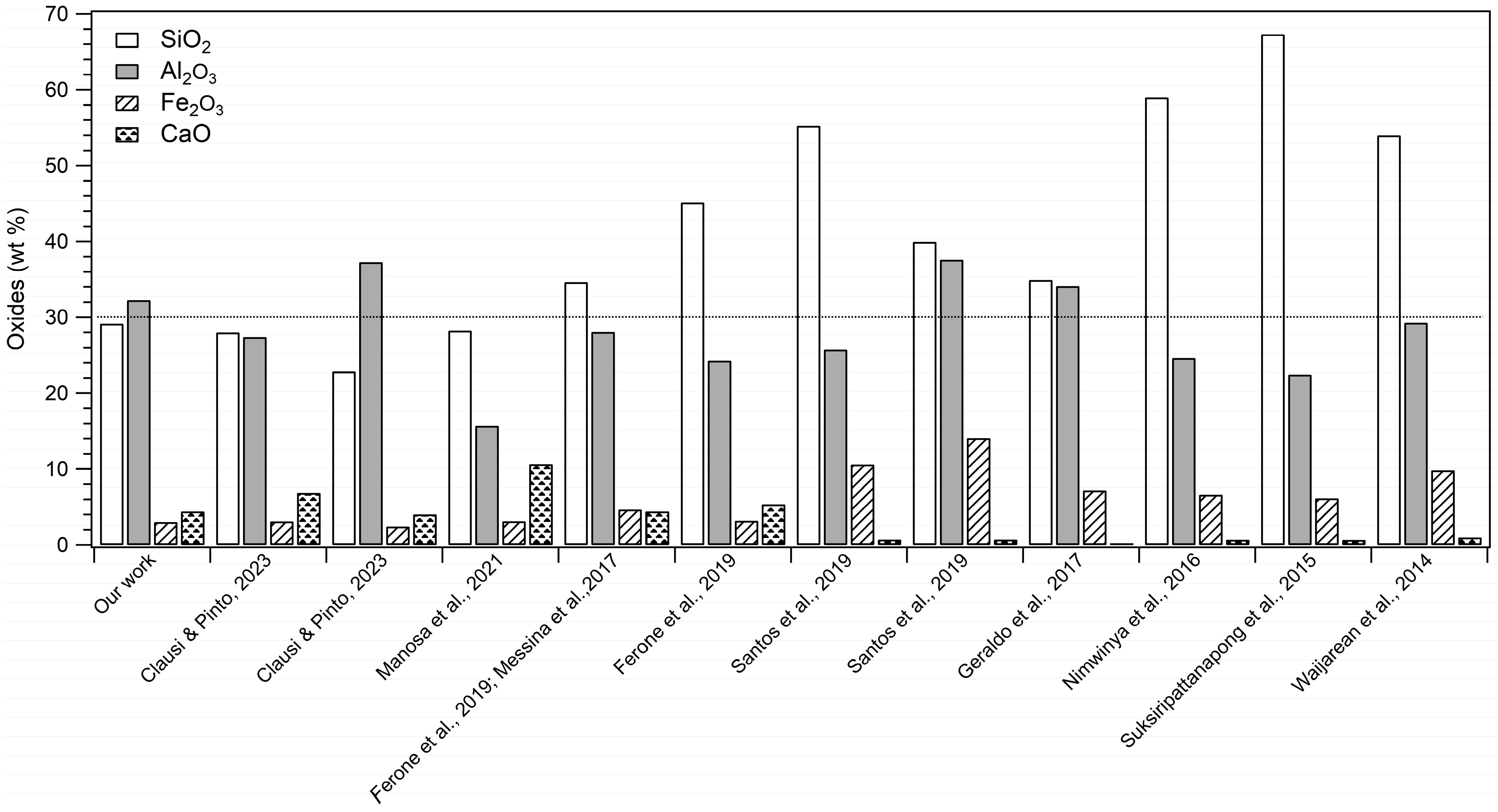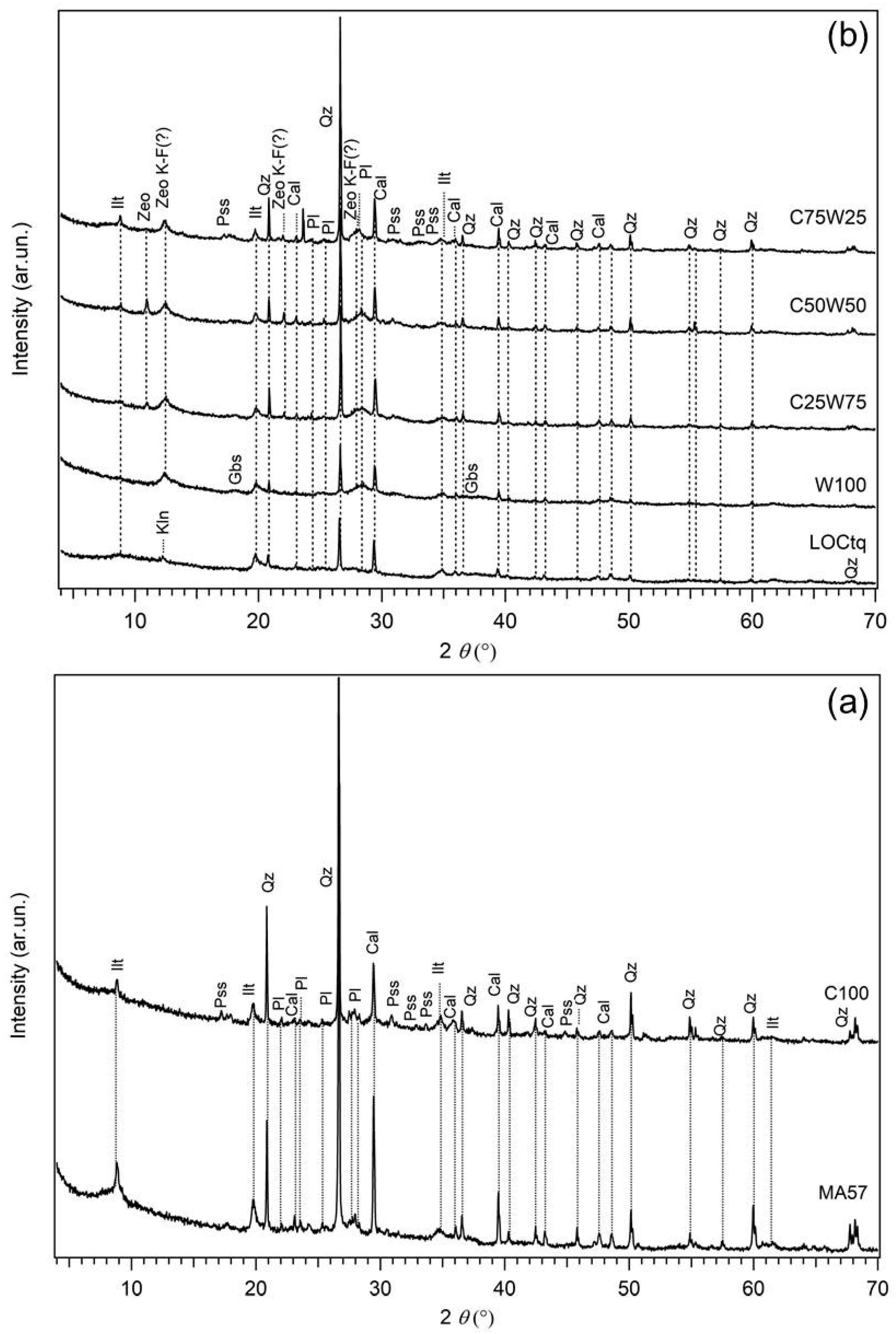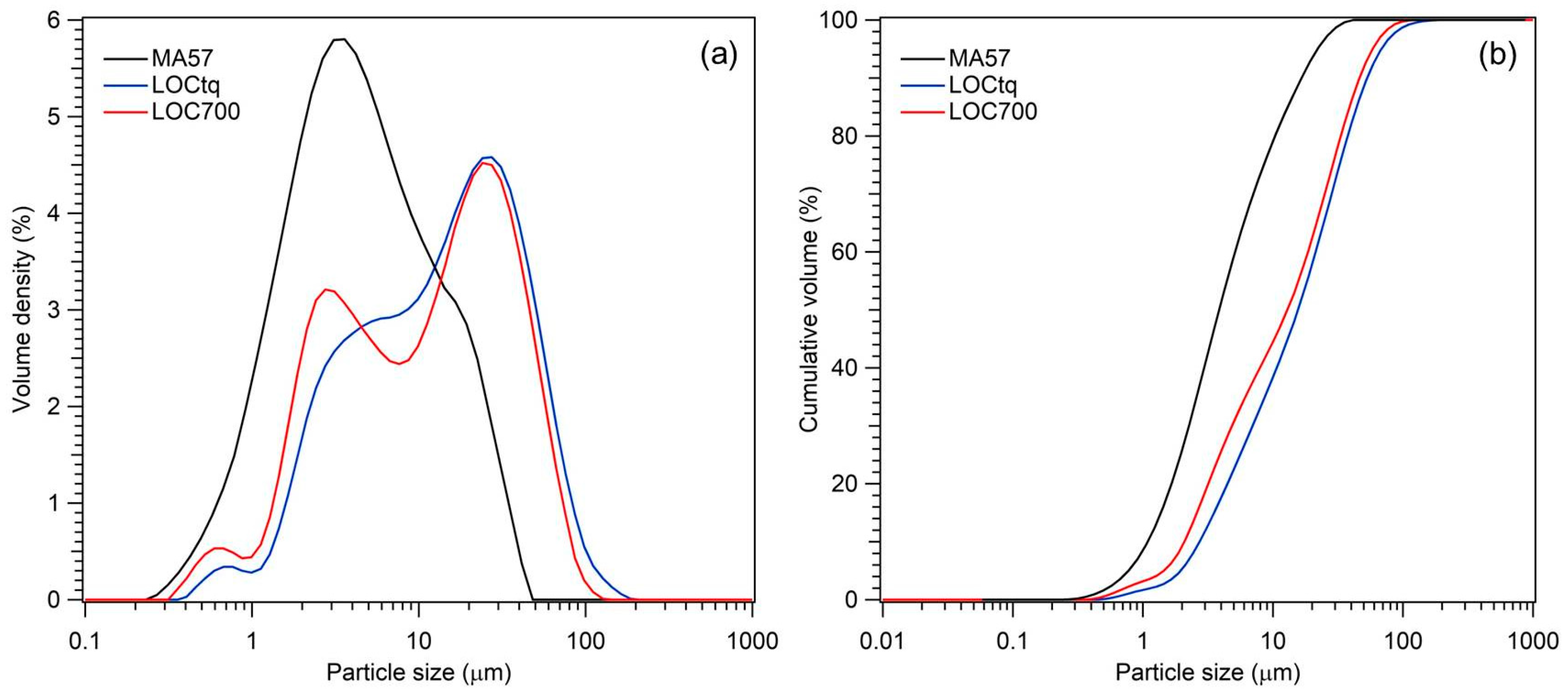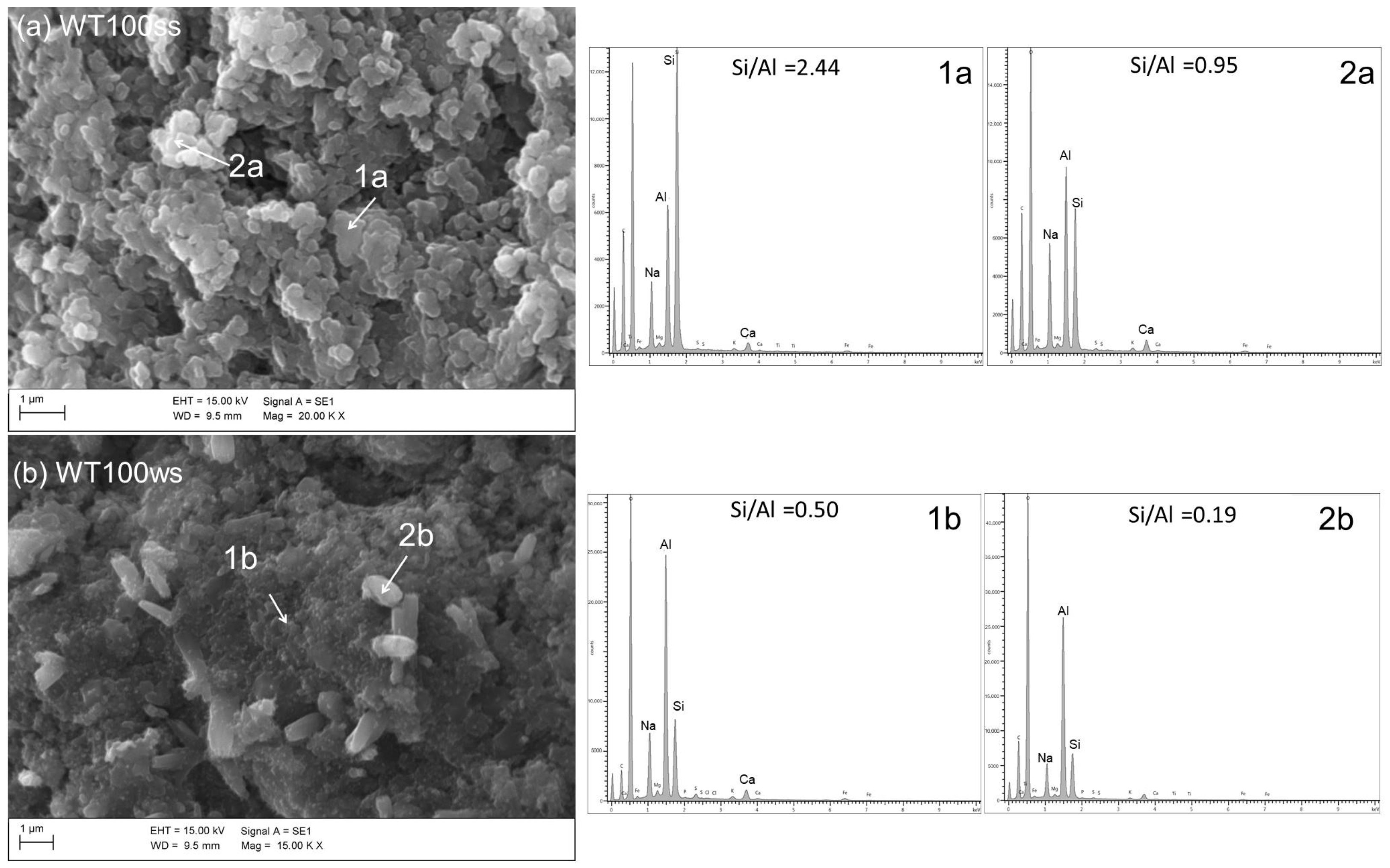Alkali Activation of Clay and Water Potabilization Sludge Binary Blends: Influence of Composition and Curing Conditions
Abstract
:1. Introduction
2. Materials and Methods
2.1. Selection of Raw Materials
2.2. Sample Preparation
- (1)
- Powders of LOCtq, LOC700, and MA57 were mixed in different weight proportions (0/100; 25/75; 50/50; 75/25) in a mechanical mixer for 5 min to create homogeneous powder blends.
- (2)
- (3)
- The mixing operations were performed by using a mechanical stirrer for 5 min at 1200 rpm.
- (4)
- The blends were poured into cubic steel moulds (40 × 40 × 40 mm3) and compacted by mechanical vibrations for 60 s by using a vibratory plate to remove entrained air.
- (5)
2.3. Characterization Methods
3. Results and Discussion
3.1. Precursors Characterization
3.2. Characterization of Alkali-Activated Blends
3.2.1. Mineralogical and Microstructural Properties of the Hardened Pastes
3.2.2. Mechanical Strengths
3.2.3. Chemical Stability of Products in Water
4. Conclusions
- -
- Alkaline activation of WPS in blends with clay can be an effective strategy to convert a waste, usually destined to landfill, into value-added products, so resulting into eco-sustainable and economic processes, considering that it is a widely and locally available industrial by-product.
- -
- In the case of mixes with uncalcined WPS the optimal formulation was reached with 25 wt% WPS, as it gave the highest compressive strengths and best chemical stability. The calcined WPS can be substituted up to 75%, but a substitution of about 25% is more suitable in the case of environmental conditions as it resulted in less dependence on the curing conditions.
- -
- The use NaOH in the alkaline activation of WPS can promote the formation of well hardened pastes, so it should be preferred to the more expensive and less sustainable sodium silicate.
- -
- The necessity of better control of the curing conditions of the blends emerges from this study in order to improve the properties of the hardened pastes and assure the reproducibility of results.
- -
- This study showed that different kinds of hybrid geopolymer-zeolite systems can be obtained at varied environmental curing temperatures, so offering interesting insights in the field of these composites as sorbent materials.
Author Contributions
Funding
Institutional Review Board Statement
Informed Consent Statement
Data Availability Statement
Acknowledgments
Conflicts of Interest
References
- Palomo, A.; Maltseva, O.; Garcia-Lodeiro, I.; Fernández-Jiménez, A.; Leonelli, C.; Mackenzie, K.J. Portland Versus Alkaline Cement: Continuity or Clean Break: “A Key Decision for Global Sustainability”. Front. Chem. 2021, 9, 705475. [Google Scholar] [CrossRef]
- Shi, C.; Jiménez, A.F.; Palomo, A. New Cements for the 21st Century: The Pursuit of an Alternative to Portland Cement. Cem. Concr. Res. 2011, 41, 750–763. [Google Scholar] [CrossRef]
- Pacheco-Torgal, F.; Castro-Gomes, J.; Jalali, S. Alkali-Activated Binders: A Review. Part 2. About Materials and Binders Manufacture. Constr. Build. Mater. 2008, 22, 1315–1322. [Google Scholar] [CrossRef]
- Davidovits, J. Geopolymers. J. Therm. Anal. 1991, 37, 1633–1656. [Google Scholar] [CrossRef]
- Duxson, P.; Provis, J.L.; Lukey, G.C.; van Deventer, J.S.J. The Role of Inorganic Polymer Technology in the Development of “Green Concrete”. Cem. Concr. Res. 2007, 37, 1590–1597. [Google Scholar] [CrossRef]
- Pacheco-Torgal, F.; Castro-Gomes, J.; Jalali, S. Alkali-Activated Binders: A Review. Part 1. Historical Background, Terminology, Reaction Mechanisms and Hydration Products. Constr. Build. Mater. 2008, 22, 1305–1314. [Google Scholar] [CrossRef]
- Liew, Y.-M.; Heah, C.-Y.; Mohd Mustafa, A.B.; Kamarudin, H. Structure and Properties of Clay-Based Geopolymer Cements: A Review. Prog. Mater. Sci. 2016, 83, 595–629. [Google Scholar] [CrossRef]
- Shi, C.; Qu, B.; Provis, J.L. Recent Progress in Low-Carbon Binders. Cem. Concr. Res. 2019, 122, 227–250. [Google Scholar] [CrossRef]
- Luukkonen, T.; Heponiemi, A.; Runtti, H.; Pesonen, J.; Yliniemi, J.; Lassi, U. Application of Alkali-Activated Materials for Water and Wastewater Treatment: A Review. Rev. Environ. Sci. Bio/Technol. 2019, 18, 271–297. [Google Scholar] [CrossRef]
- Pacheco-Torgal, F.; Labrincha, J.; Leonelli, C.; Palomo, A.; Chindaprasit, P. Handbook of Alkali-Activated Cements, Mortars and Concretes; Elsevier: Amsterdam, The Netherlands, 2014; ISBN 1782422889. [Google Scholar]
- Jindal, B.B.; Alomayri, T.; Hasan, A.; Kaze, C.R. Geopolymer Concrete with Metakaolin for Sustainability: A Comprehensive Review on Raw Material’s Properties, Synthesis, Performance, and Potential Application. Environ. Sci. Pollut. Res. 2022, 30, 25299–25324. [Google Scholar] [CrossRef]
- Provis, J.L.; Yong, S.L.; Duxson, P. 5-Nanostructure/Microstructure of Metakaolin Geopolymers. In Woodhead Publishing Series in Civil and Structural Engineering; Provis, J.L., van Deventer, J.S.J.B.T.-G., Eds.; Woodhead Publishing: Sawston, UK, 2009; pp. 72–88. ISBN 978-1-84569-449-4. [Google Scholar]
- Khalifa, A.Z.; Cizer, Ö.; Pontikes, Y.; Heath, A.; Patureau, P.; Bernal, S.A.; Marsh, A.T.M. Advances in Alkali-Activation of Clay Minerals. Cem. Concr. Res. 2020, 132, 106050. [Google Scholar] [CrossRef]
- El Khomsi, A.; Ghaezouni, A.; Kandri, N.I.; Zerouale, A.; Rossignol, S. Moroccan Clays for Potential Use as Aluminosilicate Precursors for Geopolymer Synthesis. E3S Web Conf. 2021, 240, 3001. [Google Scholar] [CrossRef]
- Valentini, L.; Contessi, S.; Dalconi, M.C.; Zorzi, F.; Garbin, E. Alkali-Activated Calcined Smectite Clay Blended with Waste Calcium Carbonate as a Low-Carbon Binder. J. Clean. Prod. 2018, 184, 41–49. [Google Scholar] [CrossRef]
- Buchwald, A.; Hohmann, M.; Posern, K.; Brendler, E. The Suitability of Thermally Activated Illite/Smectite Clay as Raw Material for Geopolymer Binders. Appl. Clay Sci. 2009, 46, 300–304. [Google Scholar] [CrossRef]
- Žibret, L.; Wisniewski, W.; Horvat, B.; Božič, M.; Gregorc, B.; Ducman, V. Clay Rich River Sediments Calcined into Precursors for Alkali Activated Materials. Appl. Clay Sci. 2023, 234, 106848. [Google Scholar] [CrossRef]
- Rahman, M.M.; Law, D.W.; Patnaikuni, I.; Gunasekara, C.; Tahmasebi Yamchelou, M. Low-Grade Clay as an Alkali-Activated Material. Appl. Sci. 2021, 11, 1648. [Google Scholar] [CrossRef]
- Valentini, L.; Moore, K.R.; Bediako, M. Sustainable Sourcing of Raw Materials for Construction: From the Earth to the Moon and Beyond. Elements 2022, 18, 327–332. [Google Scholar] [CrossRef]
- D’Elia, A.; Pinto, D.; Eramo, G.; Giannossa, L.C.; Ventruti, G.; Laviano, R. Effects of Processing on the Mineralogy and Solubility of Carbonate-Rich Clays for Alkaline Activation Purpose: Mechanical, Thermal Activation in Red/Ox Atmosphere and Their Combination. Appl. Clay Sci. 2018, 152, 9–21. [Google Scholar] [CrossRef]
- D’Elia, A.; Pinto, D.; Eramo, G.; Laviano, R.; Palomo, A.; Fernández-Jiménez, A. Effect of Alkali Concentration on the Activation of Carbonate-High Illite Clay. Appl. Sci. 2020, 10, 2203. [Google Scholar] [CrossRef]
- D’Elia, A.; Clausi, M.; Fernández-Jiménez, A.; Palomo, A.; Eramo, G.; Laviano, R.; Pinto, D. Alkali-Activated Binary Binders with Carbonate-Rich Illitic Clay. Polymers 2023, 15, 362. [Google Scholar] [CrossRef]
- Garcia Lodeiro, I.; Cristelo, N.; Palomo, A.; Fernández-Jiménez, A. Use of Industrial By-Products as Alkaline Cement Activators. Constr. Build. Mater. 2020, 253, 119000. [Google Scholar] [CrossRef]
- Bernal, S.A.; Rodríguez, E.D.; Kirchheim, A.P.; Provis, J.L. Management and Valorisation of Wastes through Use in Producing Alkali-Activated Cement Materials. J. Chem. Technol. Biotechnol. 2016, 91, 2365–2388. [Google Scholar] [CrossRef]
- Occhipinti, R.; Lanzafame, G.; Lluveras Tenorio, A.; Finocchiaro, C.; Gigli, L.; Tinè, M.R.; Mazzoleni, P.; Barone, G. Design of Alkali Activated Foamy Binders from Sicilian Volcanic Precursors. Ceram. Int. 2023, 49, 38835–38846. [Google Scholar] [CrossRef]
- Hossain, M.U.; Ng, S.T.; Antwi-Afari, P.; Amor, B. Circular Economy and the Construction Industry: Existing Trends, Challenges and Prospective Framework for Sustainable Construction. Renew. Sustain. Energy Rev. 2020, 130, 109948. [Google Scholar] [CrossRef]
- Espejel-Ayala, F.; Schouwenaars, R.; Durán-Moreno, A.; Ramírez-Zamora, R.M. Use of Drinking Water Sludge in the Production Process of Zeolites. Res. Chem. Intermed. 2014, 40, 2919–2928. [Google Scholar] [CrossRef]
- Rozhkovskaya, A.; Rajapakse, J.; Millar, G.J. Synthesis of High-Quality Zeolite LTA from Alum Sludge Generated in Drinking Water Treatment Plants. J. Environ. Chem. Eng. 2021, 9, 104751. [Google Scholar] [CrossRef]
- De Carvalho Gomes, S.; Zhou, J.L.; Li, W.; Long, G. Progress in Manufacture and Properties of Construction Materials Incorporating Water Treatment Sludge: A Review. Resour. Conserv. Recycl. 2019, 145, 148–159. [Google Scholar] [CrossRef]
- Yang, J.; Ren, Y.; Chen, S.; Zhang, Z.; Pang, H.; Wang, X.; Lu, J. Thermally Activated Drinking Water Treatment Sludge as a Supplementary Cementitious Material: Properties, Pozzolanic Activity and Hydration Characteristics. Constr. Build. Mater. 2023, 365, 130027. [Google Scholar] [CrossRef]
- Mañosa, J.; Cerezo-Piñas, M.; Maldonado-Alameda, A.; Formosa, J.; Giro-Paloma, J.; Rosell, J.R.; Chimenos, J.M. Water Treatment Sludge as Precursor in Non-Dehydroxylated Kaolin-Based Alkali-Activated Cements. Appl. Clay Sci. 2021, 204, 106032. [Google Scholar] [CrossRef]
- Ferone, C.; Capasso, I.; Bonati, A.; Roviello, G.; Montagnaro, F.; Santoro, L.; Turco, R.; Cioffi, R. Sustainable Management of Water Potabilization Sludge by Means of Geopolymers Production. J. Clean. Prod. 2019, 229, 1–9. [Google Scholar] [CrossRef]
- Geraldo, R.H.; Fernandes, L.F.R.; Camarini, G. Water Treatment Sludge and Rice Husk Ash to Sustainable Geopolymer Production. J. Clean. Prod. 2017, 149, 146–155. [Google Scholar] [CrossRef]
- Messina, F.; Ferone, C.; Molino, A.; Roviello, G.; Colangelo, F.; Molino, B.; Cioffi, R. Synergistic Recycling of Calcined Clayey Sediments and Water Potabilization Sludge as Geopolymer Precursors: Upscaling from Binders to Precast Paving Cement-Free Bricks. Constr. Build. Mater. 2017, 133, 14–26. [Google Scholar] [CrossRef]
- Nimwinya, E.; Arjharn, W.; Horpibulsuk, S.; Phoo-Ngernkham, T.; Poowancum, A. A Sustainable Calcined Water Treatment Sludge and Rice Husk Ash Geopolymer. J. Clean. Prod. 2016, 119, 128–134. [Google Scholar] [CrossRef]
- Waijarean, N.; Asavapisit, S.; Sombatsompop, K. Strength and Microstructure of Water Treatment Residue-Based Geopolymers Containing Heavy Metals. Constr. Build. Mater. 2014, 50, 486–491. [Google Scholar] [CrossRef]
- Suksiripattanapong, C.; Horpibulsuk, S.; Chanprasert, P.; Sukmak, P.; Arulrajah, A. Compressive Strength Development in Fly Ash Geopolymer Masonry Units Manufactured from Water Treatment Sludge. Constr. Build. Mater. 2015, 82, 20–30. [Google Scholar] [CrossRef]
- Hwang, C.L.; Chiang, C.H.; Huynh, T.P.; Vo, D.H.; Jhang, B.J.; Ngo, S.H. Properties of Alkali-Activated Controlled Low-Strength Material Produced with Waste Water Treatment Sludge, Fly Ash, and Slag. Constr. Build. Mater. 2017, 135, 459–471. [Google Scholar] [CrossRef]
- Babatunde, A.O.; Zhao, Y.Q. Constructive Approaches Toward Water Treatment Works Sludge Management: An International Review of Beneficial Reuses. Crit. Rev. Environ. Sci. Technol. 2007, 37, 129–164. [Google Scholar] [CrossRef]
- Ahmad, T.; Ahmad, K.; Alam, M. Sustainable Management of Water Treatment Sludge through 3‘R’ Concept. J. Clean. Prod. 2016, 124, 1–13. [Google Scholar] [CrossRef]
- Clausi, M.; Pinto, D. Valorisation of Water Potabilization Sludges as Precursors for Alkali-Activated Binders: Characterization and Feasibility Study. Materials 2023, 16, 1998. [Google Scholar] [CrossRef]
- Ahmad, T.; Ahmad, K.; Alam, M. Sludge Quantification at Water Treatment Plant and Its Management Scenario. Environ. Monit. Assess. 2017, 189, 453. [Google Scholar] [CrossRef]
- Lagaly, G.; Tufar, W.; Minihan, A.; Lovell, A. Silicates. In Ullmann’s Encyclopedia of Industrial Chemistry; John Wiley & Sons, Ltd.: Hoboken, NJ, USA, 2000; ISBN 9783527306732. [Google Scholar]
- Dell’Anna, L.; Laviano, R. Mineralogical and Chemical Classification of Pleistocene Clays from the Lucanian Basin (Southern Italy) for the Use in the Italian Tile Industry. Appl. Clay Sci. 1991, 6, 233–243. [Google Scholar] [CrossRef]
- ISO 13320; Particle Size Analysis Laser Diffraction Methods. ISO: Geneva, Switzerland, 2020.
- Rietveld, H.M. The Rietveld Method. Phys. Scr. 2014, 89, 98002. [Google Scholar] [CrossRef]
- Bergmann, J.; Friedel, P.; Kleeberg, R. BGMN—A New Fundamental Parameters Based Rietveld Program for Laboratory X-Ray Sources, Its Use in Quantitative Analysis and Structure Investigations. CPD Newsl. 1998, 20, 5–8. [Google Scholar]
- Doebelin, N.; Kleeberg, R. Profex: A Graphical User Interface for the Rietveld Refinement Program BGMN. J. Appl. Crystallogr. 2015, 48, 1573–1580. [Google Scholar] [CrossRef]
- Lancellotti, I.; Catauro, M.; Ponzoni, C.; Bollino, F.; Leonelli, C. Inorganic Polymers from Alkali Activation of Metakaolin: Effect of Setting and Curing on Structure. J. Solid. State Chem. 2013, 200, 341–348. [Google Scholar] [CrossRef]
- Duxson, P.; Provis, J.L.; Lukey, G.C.; Mallicoat, S.W.; Kriven, W.M.; Van Deventer, J.S.J. Understanding the Relationship between Geopolymer Composition, Microstructure and Mechanical Properties. Colloids Surf. A Physicochem. Eng. Asp. 2005, 269, 47–58. [Google Scholar] [CrossRef]
- Santos, G.Z.B.; Melo Filho, J.A.; Pinheiro, M.; Manzato, L. Synthesis of Water Treatment Sludge Ash-Based Geopolymers in an Amazonian Context. J. Environ. Manag. 2019, 249, 109328. [Google Scholar] [CrossRef]
- Ruiz-Santaquiteria, C.; Fernández-Jiménez, A.; Skibsted, J.; Palomo, A. Clay Reactivity: Production of Alkali Activated Cements. Appl. Clay Sci. 2013, 73, 11–16. [Google Scholar] [CrossRef]
- Provis, J.L.; Duxson, P.; van Deventer, J.S.J. The Role of Particle Technology in Developing Sustainable Construction Materials. Adv. Powder Technol. 2010, 21, 2–7. [Google Scholar] [CrossRef]
- Puertas, F.; Martínez-Ramírez, S.; Alonso, S.; Vázquez, T. Alkali-Activated Fly Ash/Slag Cements: Strength Behaviour and Hydration Products. Cem. Concr. Res. 2000, 30, 1625–1632. [Google Scholar] [CrossRef]
- Baerlocher, C.H.; Barker, R.M. The Crystal Structure of Synthetic Zeolite F. Z. Für Krist. 1974, 140, 10–26. [Google Scholar] [CrossRef]
- Arbel Haddad, M.; Ofer-Rozovsky, E.; Bar-Nes, G.; Borojovich, E.J.C.; Nikolski, A.; Mogiliansky, D.; Katz, A. Formation of Zeolites in Metakaolin-Based Geopolymers and Their Potential Application for Cs Immobilization. J. Nucl. Mater. 2017, 493, 168–179. [Google Scholar] [CrossRef]
- Gualtieri, A.; Norby, P.; Artioli, G.; Hanson, J. Kinetics of Formation of Zeolite Na-A [LTA] from Natural Kaolinites. Phys. Chem. Miner. 1997, 24, 191–199. [Google Scholar] [CrossRef]
- Rożek, P.; Król, M.; Mozgawa, W. Geopolymer-Zeolite Composites: A Review. J. Clean. Prod. 2019, 230, 557–579. [Google Scholar] [CrossRef]










| Chemical Composition (wt%) | Mineralogical Composition (wt%) c | |||||
|---|---|---|---|---|---|---|
| LOCtq | MA57 b | LOCtq | LOC700 | MA57 b | ||
| SiO2 | 29.16 | 42.06 | Quartz [SiO2] | 4.2 (±0.3) | 4.5 (±0.6) | 20.8 (±1.5) |
| TiO2 | 0.27 | 0.70 | Kaolinite [Al2Si2O5(OH)4] | 5.6 (±0.9) | ||
| Al2O3 | 32.30 | 12.93 | Illite [KAl2Si4O10(OH)2] | 23.1 (±3.0) | 11.5 (±2.7) | 20.3 (±2.4) |
| Fe2O3 | 3.00 | 8.95 | Calcite [CaCO3] | 5.0 (±0.6) | 0.4 (±0.3) | 8.5 (±0.6) |
| MnO | 0.15 | 0.20 | Plagioclase [(Ca,Na)Al2Si2O8] | 4.1 (±0.6) | 2.6 (±0.9) | 5.2 (±0.8) |
| MgO | 0.9 | 2.18 | Feldspar [KAlSi3O8] | 1.1 (±0.3) | 0.7 (±0.3) | 3.1 (±0.7) |
| CaO | 4.42 | 27.01 | Ematite [Al2O3] | 1.2 (±0.4) | ||
| Na2O | 0.17 | 0.36 | Amorphous | 56.9 (±3.9) | 80.4 (±3.3) | 41.0 (±4.4) |
| K2O | 0.90 | 2.20 | ||||
| P2O5 | 0.21 | 0.09 | ||||
| L.o.I. a | 28.51 | 3.31 | ||||
| SiO2 + Al2O3 | 61.46 | 54.99 | ||||
| SiO2/Al2O3 molar ratio | 1.53 | 5.52 | ||||
| Samples Label | Precursors Weight Ratio | S/P 2 | Compressive Strength (MPa) | Integrity Test (24 h) | Stability Test (10 d) | ||||
|---|---|---|---|---|---|---|---|---|---|
| MA57 | LOCtq | LOC700 | |||||||
| C100 | 100 | 0 | 0 | 0.56 3 | 16 (4) | ✔ | ✔ | ||
| Environmental conditions | (ss) T °C ≥ 35 °C; RH ≥ 65% | C75W25 | 75 | 25 | 0 | 0.8 | 4.1 (3) | ✔ 4 | ✔✗ 6 |
| C50W50 | 50 | 50 | 0 | 0.8 | 5.6 (1.5) | ✗ 5 | // 7 | ||
| C25W75 | 25 | 75 | 0 | 0.8 | 4.5 (1) | ✗ | // | ||
| W100 | 0 | 100 | 0 | 0.85 | // | ✗ | // | ||
| C75WT25s 1 | 75 | 0 | 25 | 0.95 | 3.8 (5) | ✔ | ✔ | ||
| C50WT50s | 50 | 0 | 50 | 0.95 | 2.9 (2) | ✔ | ✔ | ||
| C25WT75s | 25 | 0 | 75 | 0.95 | 4.9 (7) | ✔ | ✔ | ||
| WT100s | 0 | 0 | 100 | 1 | 7.1 (4) | ✔ | ✔ | ||
| (ws) 10 °C < T °C < 20 °C; RH ~50% | C75WT25w 1 | 75 | 0 | 25 | 0.95 | 7.5 (1) | ✔ | ✔ | |
| C50WT50w | 50 | 0 | 50 | 0.95 | 4.4 (3) | ✔ | ✔ | ||
| C25WT75w | 25 | 0 | 75 | 0.95 | 7.3 (1.3) | ✔ | ✔ | ||
| WT100w | 0 | 0 | 100 | 1 | 9.2 (8) | ✔ | ✔ | ||
| Precursors | WPS Pre-Treatment (°C) | Alkaline Activator | Curing Design | Compressive Strength (MPa) d | |
|---|---|---|---|---|---|
| Our work | WPS | no, 700 | NaOH | RT °C | 0–9.2 |
| Ferone et al., 2019 [32] | WPS | 650 | SS b | 25 and 60 °C for 7 days than RT °C | 3.9–15.2 |
| Nimwinya et al., 2016 [35] | WPS | 600 | NaOH + SS | 27–30 and 60 °C for 7 days than RT °C for 24 h | ~5–7 |
| Waijarean et al., 2014 [36] | WPS | no, 600, 800, 900 | NaOH | 28 °C until 60 days | 0.76–~8.5 |
| Our work | WPS (25–50–75%) a–clay | no, 700 | NaOH | RT °C | 2.9–7.5 |
| Manosa et al., 2021 [31] | WPS (5–10–20–40–80%)—clay | no | NaOH | 80 °C for 24 h then RT °C for 14 days | ~1.3–3.4 |
| Messina et al., 2017 [34] | WPS (30–50–70%)—clay sediments | 750 | NaOH + SS | 20 and 60 °C for 24 h than 20 °C, RH > 90% and RT °C | 18–23 |
| Geraldo et al., 2017 [33] | WPS (15–30–60%)—metakaolin (+sand) | no | NaOH + RHA c | 25 °C, RH = 60% | 9–~25 |
Disclaimer/Publisher’s Note: The statements, opinions and data contained in all publications are solely those of the individual author(s) and contributor(s) and not of MDPI and/or the editor(s). MDPI and/or the editor(s) disclaim responsibility for any injury to people or property resulting from any ideas, methods, instructions or products referred to in the content. |
© 2023 by the authors. Licensee MDPI, Basel, Switzerland. This article is an open access article distributed under the terms and conditions of the Creative Commons Attribution (CC BY) license (https://creativecommons.org/licenses/by/4.0/).
Share and Cite
Clausi, M.; Girardi, G.; Pinto, D. Alkali Activation of Clay and Water Potabilization Sludge Binary Blends: Influence of Composition and Curing Conditions. Sustainability 2023, 15, 16623. https://doi.org/10.3390/su152416623
Clausi M, Girardi G, Pinto D. Alkali Activation of Clay and Water Potabilization Sludge Binary Blends: Influence of Composition and Curing Conditions. Sustainability. 2023; 15(24):16623. https://doi.org/10.3390/su152416623
Chicago/Turabian StyleClausi, Marina, Gianluca Girardi, and Daniela Pinto. 2023. "Alkali Activation of Clay and Water Potabilization Sludge Binary Blends: Influence of Composition and Curing Conditions" Sustainability 15, no. 24: 16623. https://doi.org/10.3390/su152416623
APA StyleClausi, M., Girardi, G., & Pinto, D. (2023). Alkali Activation of Clay and Water Potabilization Sludge Binary Blends: Influence of Composition and Curing Conditions. Sustainability, 15(24), 16623. https://doi.org/10.3390/su152416623








